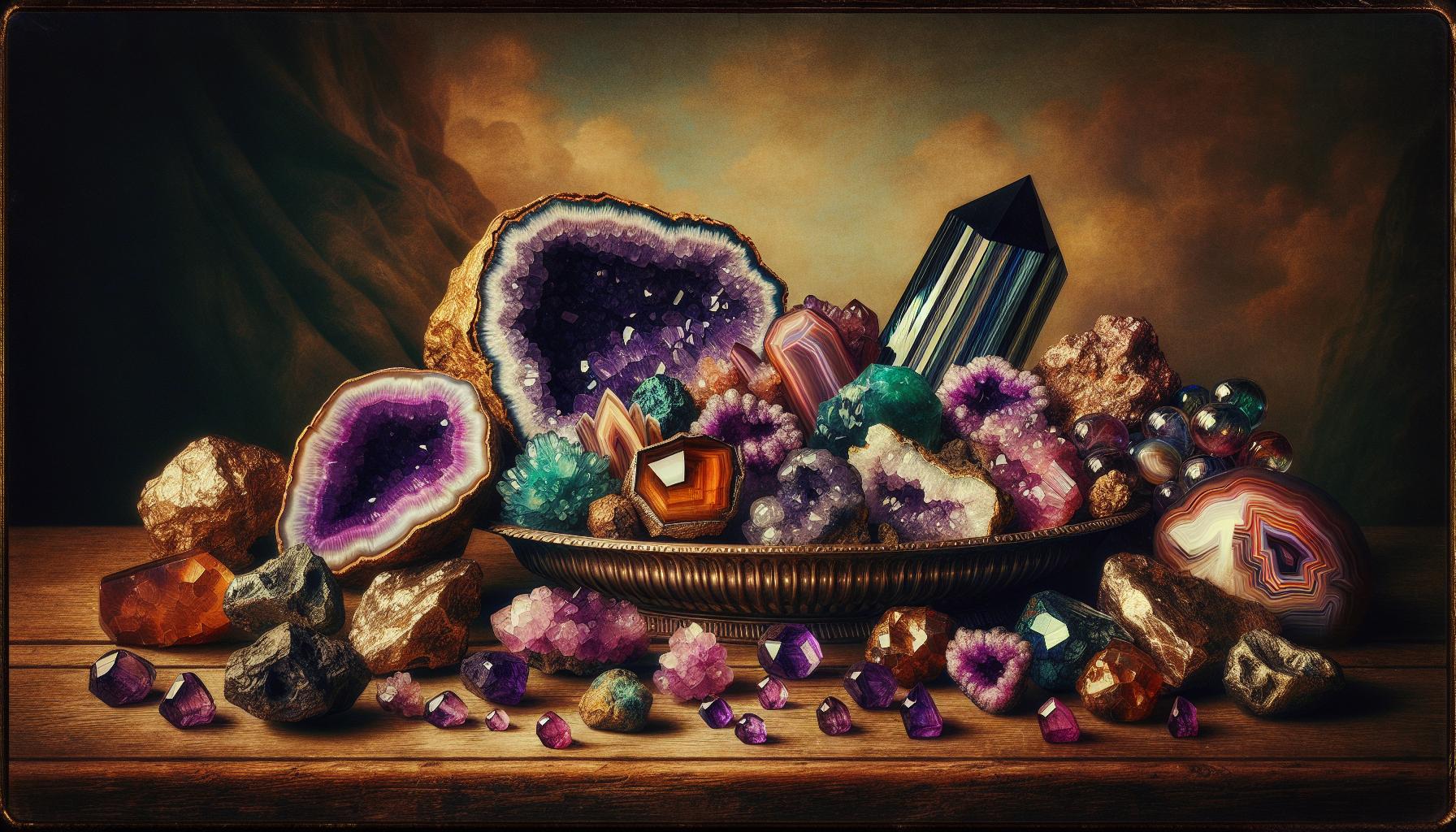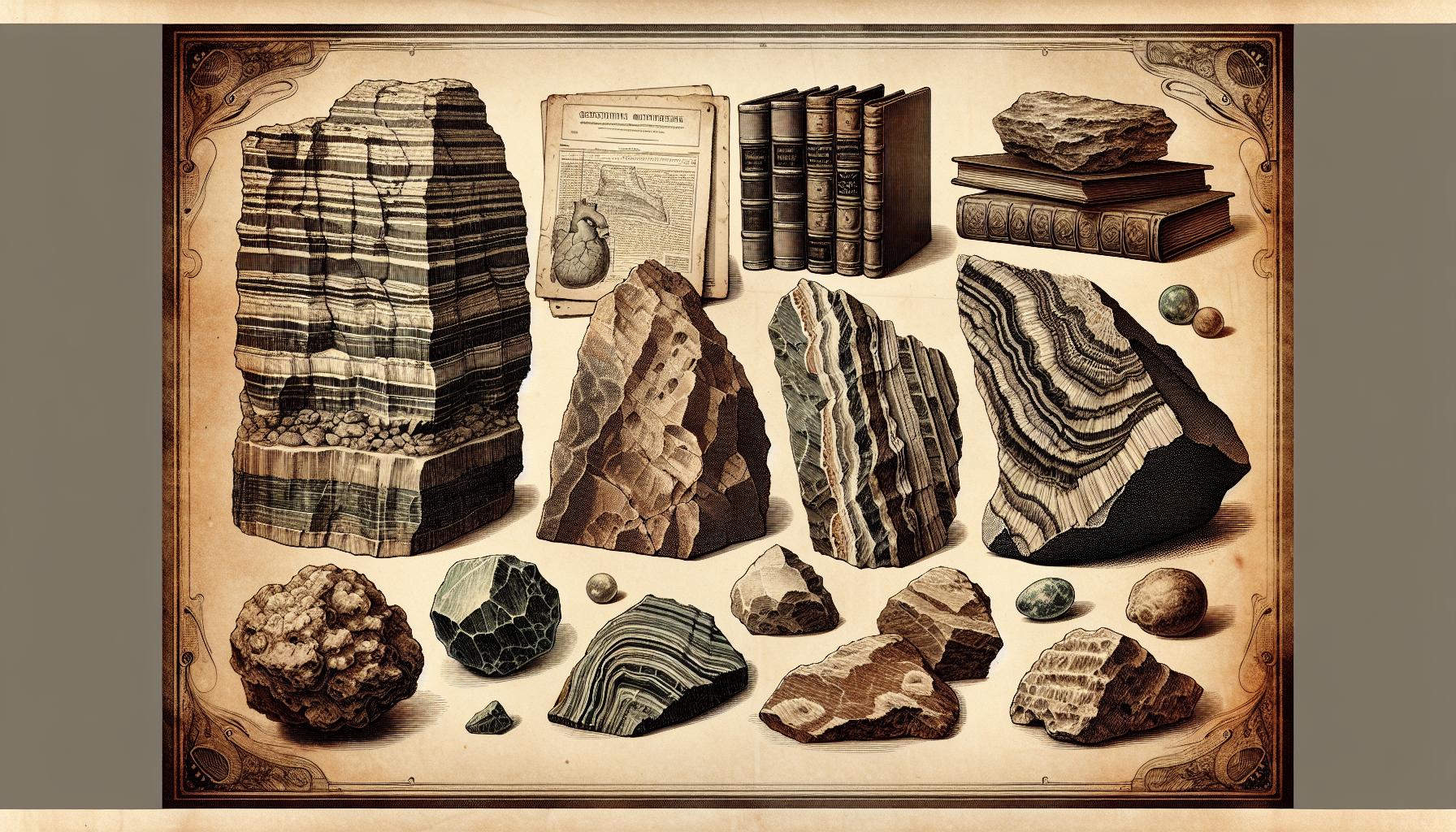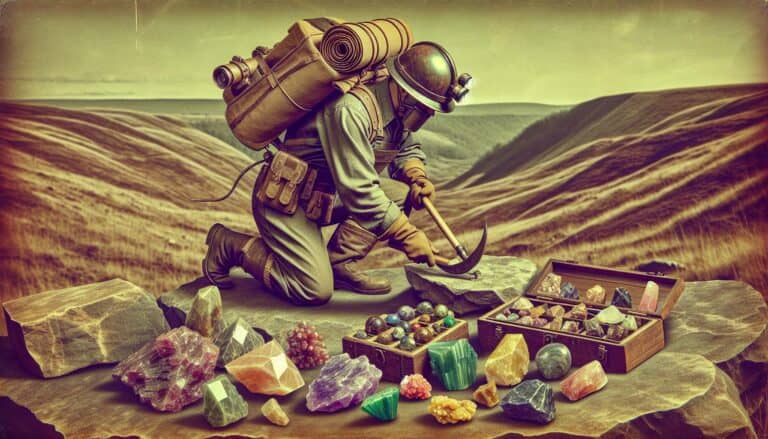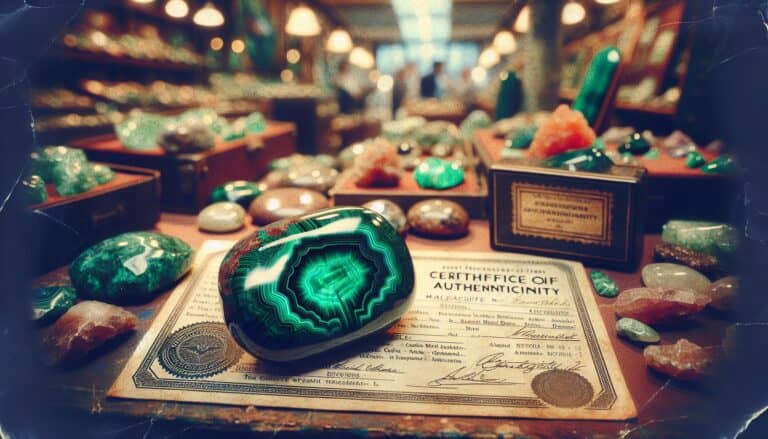Illinois may not be the first place that springs to mind when you think of rockhounding, but it’s a hidden gem teeming with geological treasures.
From the sparkling geodes in the northwestern part of the state to the fossil-rich Mazon Creek area, there’s plenty to discover.
You’ll find that the Prairie State offers a variety of locales for both amateur and seasoned rockhounds. Whether you’re searching for ancient fossils, colorful fluorite, or the elusive Keokuk geode, Illinois’s diverse geology won’t disappoint.
Let’s explore where you can dig into this rockhound’s paradise and what you might unearth.
Illinois offers a hidden world of geological treasures, perfect for rockhounds. Hamilton for Keokuk geodes and Hardin for colorful fluorite. Geode State Park and Cave-In-Rock State Park are ideal for general rock collecting and fluorite, respectively. Mazon Creek is famous for fossils, and the Mississippi River banks offer petrified wood.
Illinois Rockhounding Locations
When you’re ready to embark on your rockhounding adventure in Illinois, Keokuk geodes await you in Hamilton, while fluorite is abundant in the southern regions like Hardin and Pope Counties. Get ready to unearth a variety of geological wonders across the state’s diverse locations.
In the northwest, the Geode State Park is famous for its namesake rocks. Here’s where you can dig deep to uncover spectacular specimens. The park’s administration allows enthusiasts to collect geodes, but remember to check for any permit requirements. Venturing into the southern parts, Cave-In-Rock State Park offers fluorite in a variety of colors, making it a hotspot for rockhounds.
- Hamilton for Keokuk Geodes
- Hardin and Pope Counties for Fluorite
- Geode State Park for general rock collecting
- Cave-In-Rock State Park for colorful fluorite
Further east, the Mazon Creek area remains an iconic spot for fossil hunters. The region is known for its exceptionally preserved plant and animal fossils, including the renowned Tully Monster. Collecting in this area requires keen attention to regulations, as it’s part of a protected land area.
For those interested in petrified wood, the Mississippi River banks offer an abundance of this prized material. Strolling along the river, you’re likely to encounter pieces of history solidified in stone. Ensure you’re aware of the ownership and accessibility of these lands, as they may be privately owned or have specific collection guidelines.
| Location | Finds | Notes |
|---|---|---|
| Hamilton | Keokuk Geodes | Permit required |
| Hardin and Pope Counties | Fluorite | Variety of colors available |
| Geode State Park | Geodes | Check for collecting permits limits |
| Cave-In-Rock State Park | Fluorite | Renowned for color variation |
| Mazon Creek | Fossils | Follow regulations for collecting |
| Mississippi River banks | Petrified Wood | Be mindful of land ownership and access rights |
What Gemstones are Found in Illinois?

As a rockhound in Illinois, you’re in for a treat with the variety of gemstones awaiting your discovery. Not only will you find the sought-after Keokuk geodes and vibrant fluorite, but Illinois also harbors other precious finds.
Geodes, which can be hollow or solid, are typically lined with a layer of crystals, like quartz or calcite. The geodes found in Illinois are especially treasured for their beautiful and diverse crystal linings. Fluorite is another gemstone frequently found, particularly known for its rich purple and green hues. It’s even designated as the official state mineral of Illinois.
Beyond these, agate and chalcedony can be unearthed, often found in the northern regions along stream beds and gravel pits. These gemstones are popular for their unique banding and translucency, making them ideal for jewelry.
In southern Illinois, especially near the area of Cave-In-Rock, calcite, and barite are also common discoveries. These minerals, while not as colorful as fluorite, have their own appeal due to their crystal structures and the way they play with light.
For those with a keen eye, galena, the natural mineral form of lead sulfide, can be found as well. Not traditionally considered a gemstone, galena is prized among collectors for its metallic luster and cubic crystals.
Exploring the state’s diverse geological sites can yield a surprising array of specimens to enhance your collection. Here’s a quick list of the gems you might come across in Illinois:
- Keokuk geodes
- Fluorite
- Agate
- Chalcedony
- Calcite
- Barite
- Galena
Remember to verify the rules and regulations governing the collection of these gemstones, as some areas may be protected or require permits for rockhounding. With the appropriate permission, your next Illinois adventure could result in a trove of natural treasures.
What Sedimentary Rocks You Can Find in Illinois?

As you continue your quest for unique finds in Illinois, you’ll discover that sedimentary rocks are a prevalent part of the geologic landscape. The state’s rich geologic history has resulted in a variety of sedimentary rocks, each with its own unique properties and appeal to rockhounds.
Shale is one of the most common sedimentary rocks you’ll encounter in Illinois. Found in shades of gray, black, green, or red, it’s a fine-grained rock formed from mud that has compacted over time. While shale might not be the most exciting find for some, its presence is a marker of the extensive sedimentary deposits in the region.
Limestone, another abundant rock type, is primarily composed of calcite and aragonite. It’s often sought after for its fossil content, giving you a glimpse into the ancient marine environments that once covered Illinois. The state’s famous Mazon Creek area is a hot spot for fossil hunters, thanks to its rich deposits of limestone.
Sandstone, with its often spectacular layers and colors, is also widely distributed in Illinois. Variations such as the Starved Rock sandstone are popular among rock collectors for their distinctive aesthetics and the stories they tell of ancient rivers and deserts.
When searching for these rocks, keep in mind that Illinois is also home to some lesser-known sedimentary variations including:
- Dolomite, similar to limestone but with a higher magnesium content
- Siltstone, finer than sandstone but coarser than shale
- Chert, a hard, silica-rich rock often found in nodules or layers within limestone
Remember, successful rockhounding in Illinois requires knowledge of where sedimentary layers are exposed. Natural cliffs, quarry walls, and riverbanks can be excellent places to begin your search. Always ensure you’re collecting legally and responsibly, respecting the guidelines for land use in different areas.
Each rock you find tells a part of Illinois’s storied past. Whether it’s the remnants of an ancient sea embedded in limestone or the ripples of a prehistoric desert preserved in sandstone, these sedimentary treasures offer a fascinating window into the Earth’s history.
What Metamorphic Rocks are found in Illinois?
As you continue your rockhounding journey through Illinois, you might wonder about the presence of metamorphic rocks in a state so rich in sedimentary geology. Interestingly, Illinois isn’t particularly known for its metamorphic formations; the state’s geological activities typically haven’t had the necessary conditions of extreme pressure and temperature to form such rocks.
However, there are exceptions. Gneiss and Slate, two classic metamorphic rocks, can occasionally be unearthed. They’re not as prevalent as the sedimentary rocks dotting the state’s landscape, but they do provide further intrigue to the diligent rockhound.
Seek out the ancient fault zones where the Earth’s movements might have created enough pressure to metamorphose pre-existing materials. Here’s what you may come across:
- Gneiss: Exhibiting its characteristic banded patterns, gneiss is sometimes found in Illinois, particularly in the older, deeper sections of quarries.
- Slate: Less common than gneiss but not unheard of, slate in Illinois can often be located near old coal mining areas where past geologic stresses were present.
Although these metamorphic varieties are few, their discovery is a significant deviation from the state’s sedimentary story. If you’re determined to find metamorphic rocks, your best bet is to investigate areas around old mines and quarries. These sites can unearth layers of Earth that were once buried deep enough to undergo the transformation process.
It’s essential to respect property boundaries and secure permissions where needed. Research access regulations for quarries and mines as these are often private or restricted due to safety concerns.
Remember, rockhounding is as much about appreciating the process of geological change as it is about the thrill of the find. Each metamorphic rock you discover holds a story, a transformative tale locked within its grains and compositions, awaiting your exploration. Keep your eyes peeled for these geological gems, and you might just add a rare find to your collection.
What Igneous Rocks can You Find in Illinois?
As you delve into rockhounding in Illinois, you might be curious about the igeneous rocks available in an area overwhelmingly dominated by sedimentary stones. Though not as common as sedimentary rocks, igeneous varieties do make an appearance in the Prairie State. You’ll find extrusive rocks like basalt which are primarily formed from ancient volcanic activity.
Over the years, these igneous rocks have been transported by glacial movement and now are scattered throughout the northern part of Illinois. The presence of these rocks is an intriguing departure from the state’s usual geology. If you’re on the hunt for igneous rocks, your best bet is to explore glacial drift areas where you’ll find specimens such as:
- Basalt
- Granite
- Rhyolite
These rocks, while not indigenous to the region, offer a glimpse into the state’s geological past. The key to finding these treasures lies in researching areas with histories of glacial deposition.
Furthermore, if you’re interested in igneous rocks like granite, you’re in luck. Pieces of granite can also be found in riverbeds and gravel pits where erosion has carried them over time. Exploring old streams and construction sites might yield well-rounded granite cobbles that have been smoothed by water and time.
While rockhounding for igneous rocks, remember to respect private property and always seek permission before collecting on someone else’s land. With patience and persistence, you’ll add some of the most exceptional igneous specimens to your collection, each bearing the ancient secrets from deep within the Earth.
Panning for Gold in Illinois
Believe it or not, gold panning in Illinois is a real possibility, although it’s not as abundant as in other parts of the United States. You might be wondering, “Where can I find gold?” Start with the rivers that have a history of glacial deposits since they’re more likely to contain fine gold particles.
Prime Locations for Gold Prospecting
Many enthusiasts turn to the state’s northwestern areas where streams and rivers are more prone to carry gold deposits. Here are a few hotspots you should consider:
- Spoon River
- Sangamon River
- Illinois River
These locations have reported findings of small gold flakes, especially near the towns of Toulon and Alpha. Keep your expectations in check; you’re looking for flour gold—very fine particles of gold that can be captured only with careful panning.
Gold Panning Techniques
Success in gold panning comes down to technique and patience. When you’re starting out, use a classifier to separate larger rocks and debris from your potential gold-bearing sediment. Shake the pan gently, with water, to help the gold settle at the bottom. Remember, it’s density you’re relying on—the gold will sit below the less dense sediments.
Equipment and Regulations
Before you rush out, make sure you’re equipped with the right gear:
- A gold pan
- A sluice box (optional, for more serious endeavors)
- A classifier
As for regulations, ensure you’re not trespassing on private property and check with local laws regarding mineral collection. In some cases, you may need a permit from the Department of Natural Resources. It’s also vital to adhere to any environmental guidelines to protect the ecosystem.
Panning for gold in Illinois may require a bit more effort compared to other states, but the potential for discovery fuels the hobby. Each pan of sediment provides a fresh opportunity to uncover something precious, mirroring your quest for unique rocks in your rockhounding journey across Illinois.
Rocks and Minerals Found in Illinois
When you set out on your rockhounding adventure in Illinois, you’ll discover a diverse array of rocks and minerals. Illinois is particularly noted for fluorite, once named the state mineral, and you can find it in a variety of colors, including purple, green, and yellow.
Apart from fluorite, keokuk geodes are a unique find in the state. These geological structures often house a crystalline interior made of quartz, calcite, or even more rare minerals like sphalerite. They mainly surface along the Mississippi River, waiting for keen-eyed rockhounds.
Here’s a brief list of what you might encounter:
- Chalcopyrite: A flashy, brass-yellow mineral.
- Galena: The state’s official mineral, notable for its metallic luster and cubic structure.
- Quartz: From clear rock crystal to smoky quartz, its varieties are abundant.
- Calcite: Often found in limestone quarries, adding to your collection’s diversity.
Fossils are also abundant in Illinois, thanks to its prehistoric marine environments. Rockford, Mazon Creek, and the Mississippi River bluffs offer fertile grounds for finding these remnants of ancient life.
Let’s dive into some specifics:
| Mineral | Locations |
|---|---|
| Fluorite | Hardin and Pope Counties |
| Keokuk Geodes | Hamilton and White Counties, near the Mississippi River |
| Chalcopyrite | Shawnee National Forest |
| Galena | Northwestern Illinois, especially around Galena |
| Quartz Variants | Statewide, especially in riverbeds and glacial drift areas |
| Calcite | Limestone quarries in the northern regions |
When planning your trips, remember that the best spots may require a bit of hiking or digging, so gear up appropriately. And it can’t be stressed enough – always seek permission before entering private lands or dedicated natural areas.
Illinois’s geological landscape offers more than just a pastime; it’s a treasure hunt that enriches your collection and knowledge. Keep your eyes peeled for the sparkle amid the ordinary rocks – you never know when you might stumble upon a rare find that has nestled beneath the Illinois soil for millions of years.
Where Can I Find Fossils in Illinois?
Mazon Creek is arguably your best bet when it comes to fossil hunting in Illinois. This renowned fossil site is approximately 50 miles southwest of Chicago and is famous for its exceptionally preserved plant and animal fossils that hail from the Pennsylvanian period. Fossils you can discover here include ferns, jellyfish, and even the state fossil, the Tully Monster.
Entering Mazon Creek, you’ll need to head to the Mazonia-Braidwood State Fish and Wildlife Area. Remember, the best time to search for these treasures is after a heavy rain, which can help expose fossil nodules. However, ensure you’re familiar with the rules of the site as part of it is a designated nature preserve.
For those interested in prehistoric marine life, the Fayetteville Shale in southern Illinois is an area that should not be missed. Here lie remnants of ancient sea creatures embedded in shale deposits. Crinoids and brachiopods are quite common in these parts and tell the tale of Illinois’s vast prehistoric oceans.
Fluorite mines in Hardin and Pope Counties also offer potential fossil finds. Though primarily sought for the beautiful fluorite crystals, these mines also yield crinoids and other marine fossils from time to time. If you’re planning to explore these areas, make sure you have permission, as many of the mines are on private property.
Local Stream Beds and Cliffs can also be fruitful for fossil hunters. As the water erodes the earth, it’ll often reveal fossils that have been hidden for millennia. Keep an eye out for cliffs and embankments along rivers and streams, especially where rock layers are visible. Take note of the stone types — limestone and sandstone often harbor fossils.
When you’re geared up for your next fossil hunting adventure in Illinois, safety should be your priority. Always wear appropriate gear, and stay aware of your surroundings. And while you’re out discovering the state’s ancient past, respect the land. Leave it as pristine as you found it, ensuring the hobby can be enjoyed for generations to come.
Illinois Rockhounding Laws & Regulations
When planning your rockhounding adventure in Illinois, it’s crucial to be aware of the state laws and regulations that govern the collection of rocks, minerals, and fossils. Ignorance of the laws can lead to hefty fines or legal troubles, so make sure you’re informed.
Public Lands offer a myriad of opportunities for rockhounding enthusiasts, but they come with regulations to preserve the natural heritage. You’re generally allowed to collect specimens on public land for personal use and in reasonable quantities. However, keep in mind that it’s illegal to sell anything you collect from public lands without appropriate permits.
Private Property poses a different situation. You must always seek permission from the landowner before entering and collecting. Never assume that undeveloped or uninhabited land is available for public use. Trespassing can not only sour relationships with locals but also result in prosecution.
In Illinois, some areas are classified as Protected Sites where collecting is strictly prohibited to safeguard ecological and historical significance. These include but are not limited to:
- State Parks
- Nature Preserves
- Historical Sites
Fossil Collecting is particularly sensitive in Illinois. The famed Mazon Creek area, a hotbed for fossil collectors, requires a permit for fossil collecting. Permits can typically be obtained from the Illinois Department of Natural Resources (IDNR) which oversees the application process.
The table below outlines basic information on obtaining a Mazon Creek Fossil Collecting Permit:
| Requirement | Detail |
|---|---|
| Age Limit | Must be 18 or accompanied by a guardian |
| Application Process | Available through the IDNR website or at select park offices |
| Fee | No fee; however, conditions may apply |
| Usage | Strictly for non-commercial, personal use only |
| Collection Limit | Quantitative restrictions may be specified |
Stay abreast of local news as the rockhounding landscape can change with new legislation or land management decisions. Resources such as the IDNR website, rockhounding clubs, and online communities are valuable for staying informed and ensuring a responsible and legal rockhounding experience. Your due diligence in respecting these regulations will help preserve Illinois’ geological wonders for future generations and ensure the continuation of rockhounding as a treasured pastime.
Rockhounding Tips for Beginners in Illinois
Gearing Up: Essential Tools for Rockhounding
Embarking on your first rockhounding adventure requires some essential tools to ensure a productive and enjoyable experience. Start by equipping yourself with a durable geological hammer for chipping rocks and a chisel to extract specimens sustainably. Don’t forget to carry safety glasses to protect your eyes from flying debris. Because Illinois terrain can vary, bring gloves for handling sharp rocks and sturdy boots for stable footing.
For collection and identification, pack clear plastic bags or containers to separate and label your finds. A magnifying glass is handy for close inspection of mineral details. To navigate the terrain and locate potential hotspots, rely on a GPS device or detailed map of the area you’re exploring.
Remember, investing in a good backpack will enable you to comfortably carry your gear and finds. Consider also bringing a notebook to record the details of your trip, such as locations, weather conditions, and characteristics of your discoveries.
Safety Tips While Rockhounding
Your safety should be your top priority while rockhounding. Always let someone know where you’re going and when you expect to return. Check the weather forecast before venturing out, as Illinois weather can be unpredictable and affect ground stability.
Stay hydrated by bringing plenty of water, and pack sunscreen and a hat to shield yourself from the sun. Be mindful of wildlife and plants, and keep a safe distance from any potential hazards. Never rockhound alone; having a partner ensures that help is at hand should an emergency arise.
Ensure you’re familiar with the first aid basics in case of minor injuries. Insect repellent is also a must to protect yourself from mosquitoes and ticks, prevalent in Illinois’ wilderness areas.
Legal Guidelines for Rockhounding Enthusiasts
Understanding and adhering to legal guidelines is essential for a responsible rockhound. First and foremost, never trespass on private property without explicit permission from the landowner. Your rockhounding activities must comply with all state and federal land management laws.
Some areas may require a permit to collect, particularly when looking for fossils, as in the Mazon Creek area. Check with local Department of Natural Resources offices to acquire the necessary permits and to gain knowledge about any collecting restrictions or site closures.
Respect the environment by practicing leave no trace principles. Take only what you need and be sure to fill any holes you dig. It’s critical to preserve sites for future enthusiasts and to maintain the natural landscape.
Remember to stay current with any changes in legislation or land management decisions that might affect your rockhounding. By following these guidelines, you’ll contribute to the sustainable practice of rockhounding and ensure these activities can be enjoyed for generations to come.
By keeping these essential tips in mind, you’ll be set for a rewarding and conscientious rockhounding journey in Illinois.
Conclusion: Illinois Rockhounding Guide & Map
Embarking on your rockhounding adventure in Illinois, you’re now equipped with the knowledge to uncover the state’s geological treasures.
Remember to gear up with the right tools, prioritize safety, and stay within the bounds of the law. With the diverse array of metamorphic and igneous rocks awaiting, and even the thrill of gold panning within reach, your explorations are sure to be fruitful. Keep this guide handy, respect the environment, and most importantly, enjoy the journey as you delve into the rich terrain that Illinois offers to rockhounds.
Happy hunting!







